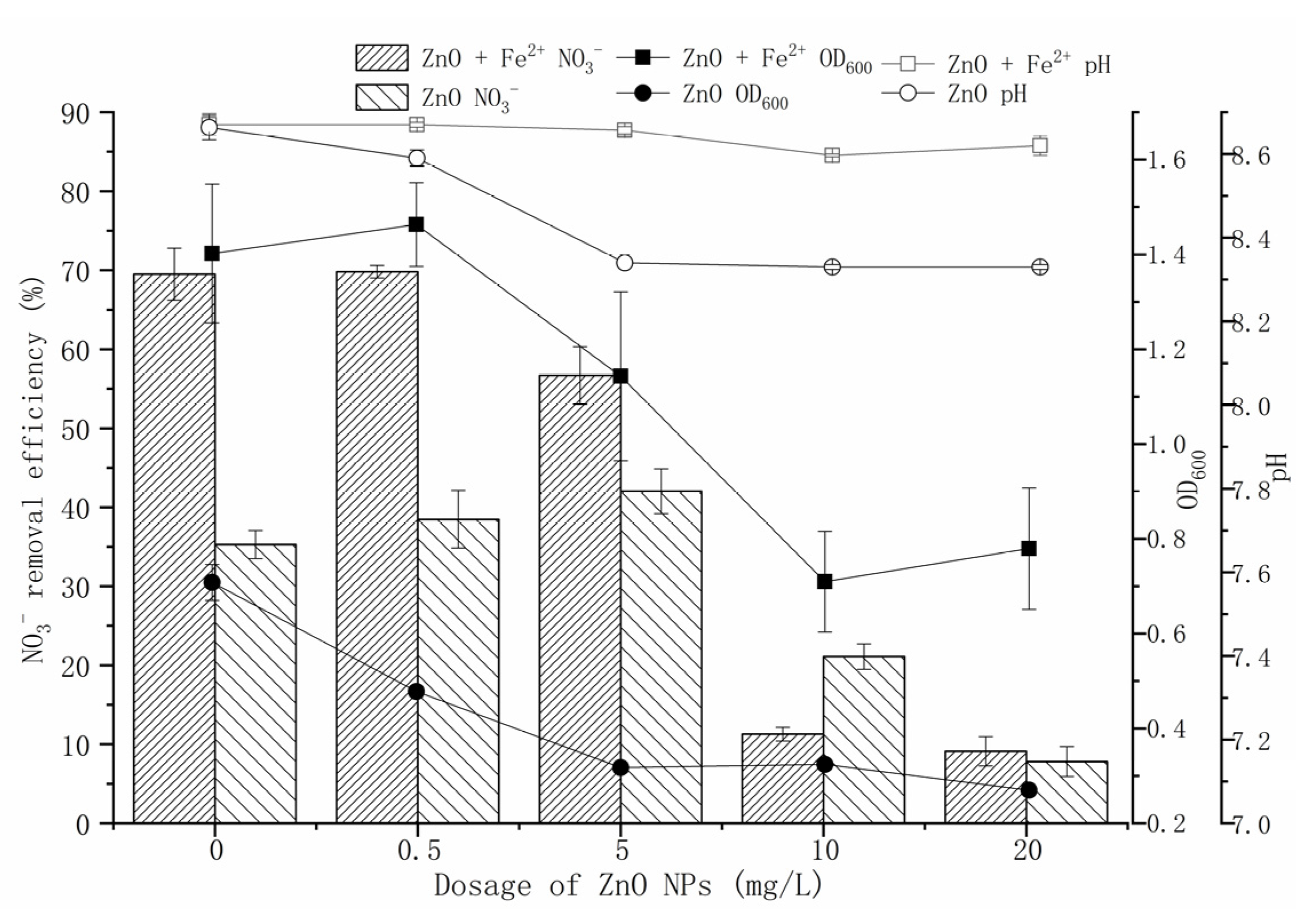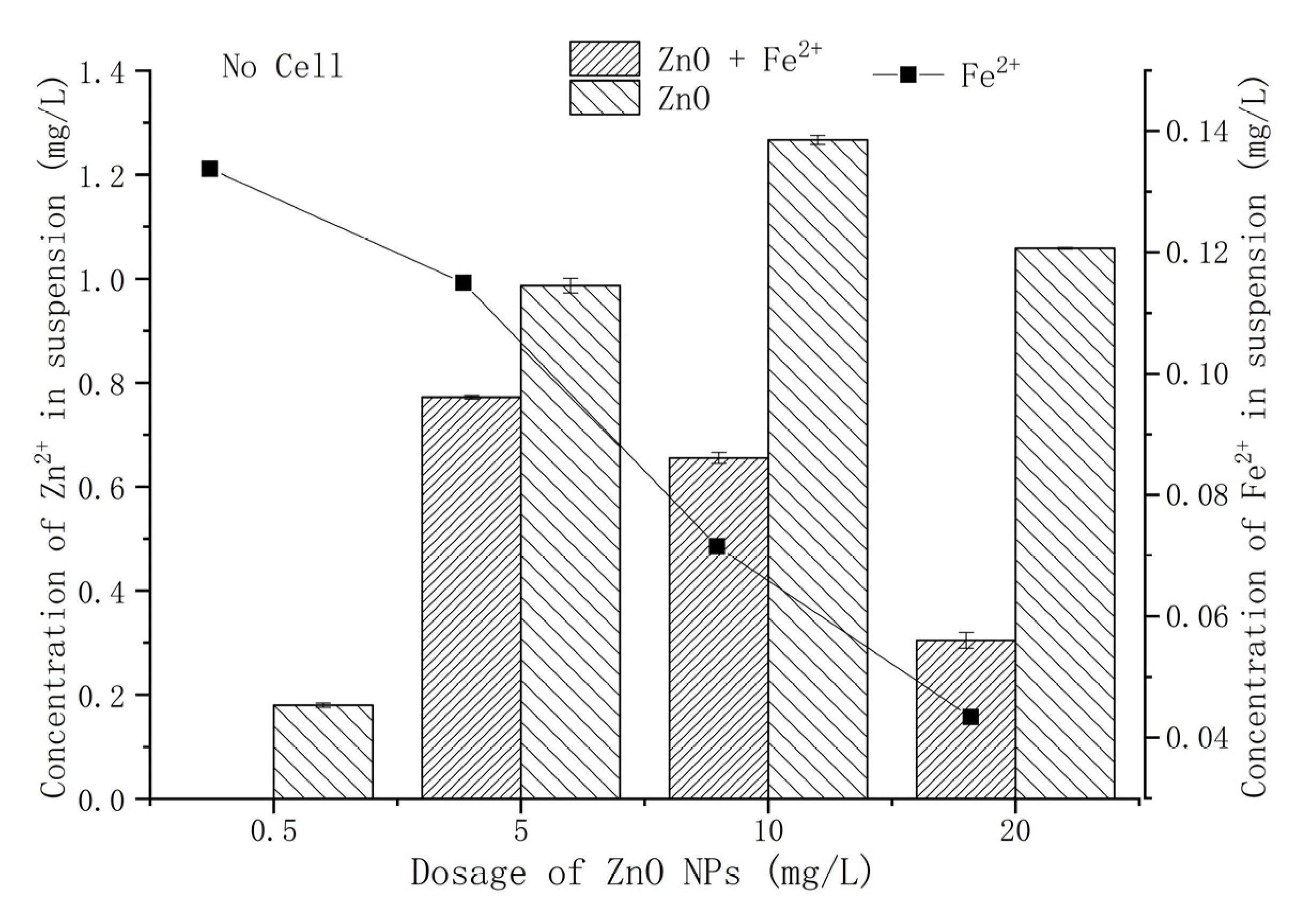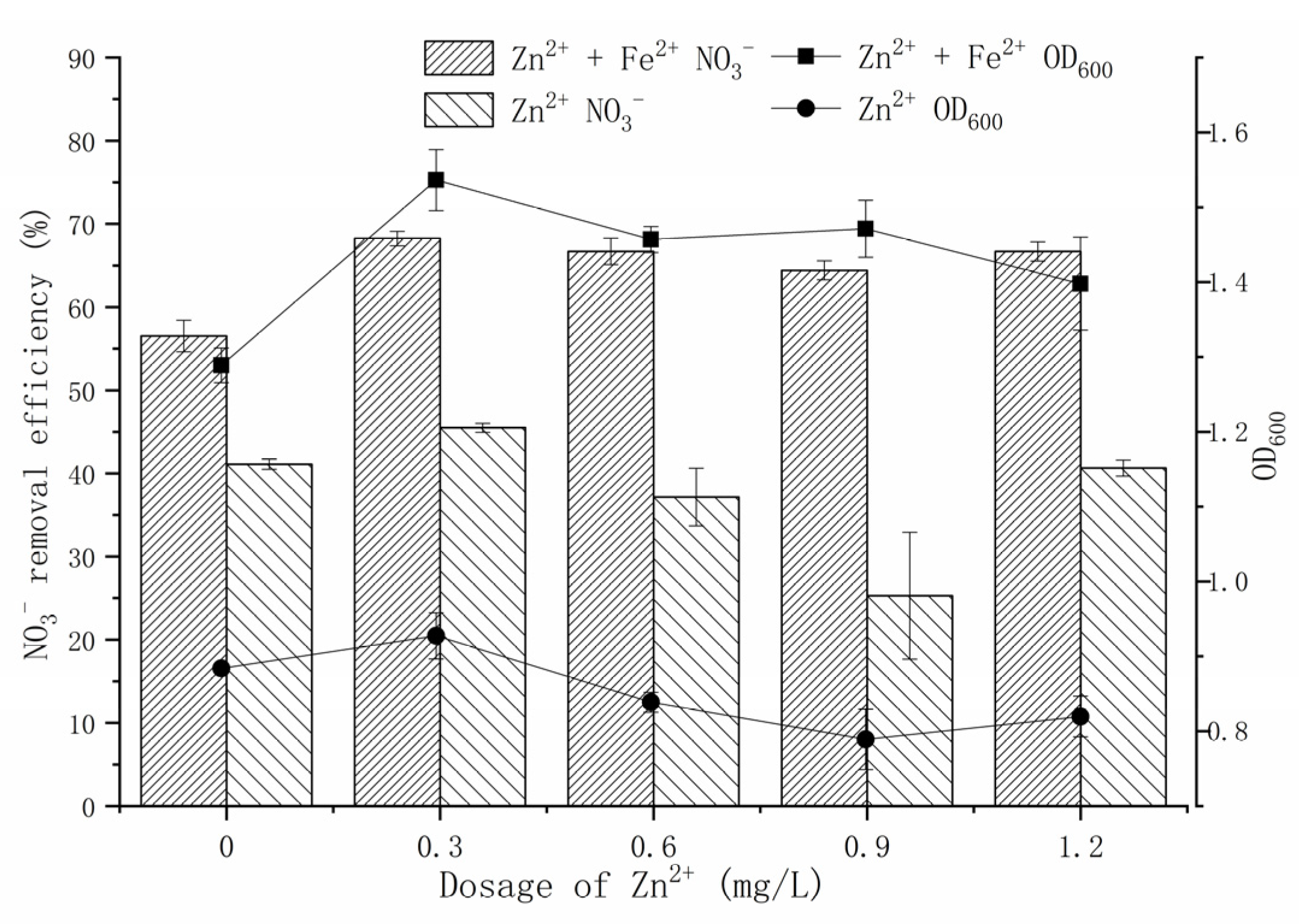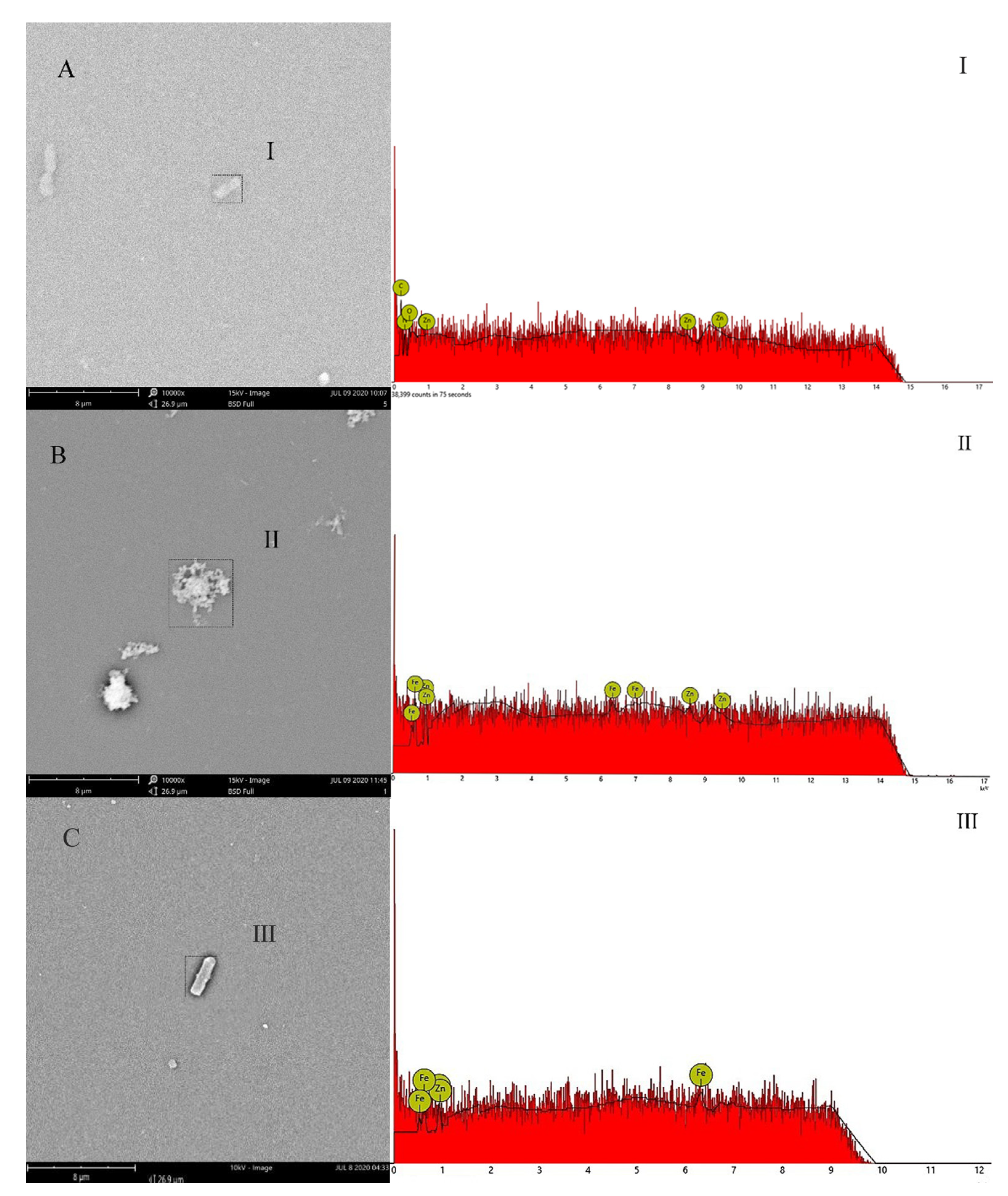Fe2+ Alleviated the Toxicity of ZnO Nanoparticles to Pseudomonas tolaasii Y-11 by Changing Nanoparticles Behavior in Solution
Abstract
:1. Introduction
2. Materials and Methods
2.1. Bacterium and Culture Media
2.2. ZnO-NP Preparation and Characterization
2.3. Evaluation of Mg2+ and Fe2+ on NO3− Removal Performance of Strain Y-11
2.4. Evaluation of Fe2+ on NO3− Removal Performance of Strain Y-11 under ZnO-NPs (Zn2+) Stress
2.5. Observation of ZnO-NPs Adsorption on Strain Y-11 Surface with or without Fe2+
2.6. FTIR Analysis
2.7. Analysis and Calculation
3. Results
3.1. Effects of Fe2+ on Cell Proliferation and NO3− Removal of P. tolaasii Y-11
3.2. Effects of Fe2+ on Cell Proliferation and NO3− Removal of P. tolaasii Y-11 under ZnO-NPs Stress
3.3. Effect of Fe2+ on the Release of Zn2+ from ZnO-NPs
3.4. Effect of Fe2+ on Cell Proliferation and NO3− Removal of P. tolaasii Y-11 under Zn2+ Stress
3.5. Effects of Fe2+ on the Main Functional Groups of the Interaction between ZnO-NPs and Strain Y-11
3.6. Effects of Fe2+ on the Hydrodynamic Diameter of ZnO-NPs
3.7. Effects of Fe2+ on the Adsorption of ZnO-NPs on the Surface of Strain Y-11
4. Discussion
Supplementary Materials
Author Contributions
Funding
Institutional Review Board Statement
Informed Consent Statement
Data Availability Statement
Conflicts of Interest
References
- Hu, W.; Tian, J.; Zang, N.; Gao, Y.; Chen, L. Study of the development and performance of centralized wastewater treatment plants in Chinese industrial parks. J. Clean. Prod. 2019, 214, 939–951. [Google Scholar] [CrossRef]
- Paredes, I.; Otero, N.; Soler, A.; Green, A.J.; Soto, D.X. Agricultural and urban delivered nitrate pollution input to Mediterranean temporary freshwaters. Agric. Ecosyst. Environ. 2020, 294, 106859. [Google Scholar] [CrossRef]
- Grant, S.B.; Azizian, M.; Cook, P.; Boano, F.; Rippy, M.A. Factoring stream turbulence into global assessments of nitrogen pollution. Science 2018, 359, 1266–1269. [Google Scholar] [CrossRef] [PubMed] [Green Version]
- Li, Y.; Wang, Y.; Fu, L.; Gao, Y.; Zhao, H.; Zhou, W. Aerobic-heterotrophic nitrogen removal through nitrate reduction and ammonium assimilation by marine bacterium Vibrio sp. Y1-5. Bioresour. Technol. 2017, 230, 103–111. [Google Scholar] [CrossRef] [PubMed]
- Huang, X.; Weisener, C.G.; Ni, J.; He, B.; Xie, D.; Li, Z. Nitrate assimilation, dissimilatory nitrate reduction to ammonium, and denitrification coexist in Pseudomonas putida Y-9 under aerobic conditions. Bioresour. Technol. 2020, 312, 123597. [Google Scholar] [CrossRef]
- Chen, Q.; Li, T.; Gui, M.; Liu, S.; Zheng, M.; Ni, J. Effects of ZnO nanoparticles on aerobic denitrification by strain Pseudomonas stutzeri PCN-1. Bioresour. Technol. 2017, 239, 21–27. [Google Scholar] [CrossRef]
- Osmond, M.J.; McCall, M. Zinc oxide nanoparticles in modern sunscreens: An analysis of potential exposure and hazard. Nanotoxicology 2009, 4, 15–41. [Google Scholar] [CrossRef]
- Zhang, D.Q.; Eng, C.Y.; Stuckey, D.C.; Zhou, Y. Effects of ZnO nanoparticle exposure on wastewater treatment and soluble microbial products (SMPs) in an anoxic-aerobic membrane bioreactor. Chemosphere 2017, 171, 446–459. [Google Scholar] [CrossRef]
- Zhang, X.; Zhou, Y.; Xu, T.; Zheng, K.; Zhang, R.; Peng, Z.; Zhang, H. Toxic effects of CuO, ZnO and TiO2 nanoparticles in environmental concentration on the nitrogen removal, microbial activity and community of Anammox process. Chem. Eng. J. 2018, 332, 42–48. [Google Scholar] [CrossRef]
- Wu, Q.; Huang, K.; Sun, H.; Ren, H.; Zhang, X.-X.; Ye, L. Comparison of the impacts of zinc ions and zinc nanoparticles on nitrifying microbial community. J. Hazard. Mater. 2018, 343, 166–175. [Google Scholar] [CrossRef]
- Zhang, Y.; Xu, R.; Xiang, Y.; Lu, Y.; Jia, M.; Huang, J.; Xu, Z.; Cao, J.; Xiong, W.; Yang, Z. Addition of nanoparticles increases the abundance of mobile genetic elements and changes microbial community in the sludge anaerobic digestion system. J. Hazard. Mater. 2021, 405, 124206. [Google Scholar] [CrossRef]
- Zheng, X.; Wu, R.; Chen, Y. Effects of ZnO nanoparticles on wastewater biological nitrogen and phosphorus removal. Environ. Sci. Technol. 2011, 45, 2826–2832. [Google Scholar] [CrossRef] [PubMed]
- Cheng, Y.-F.; Zhang, Z.-Z.; Li, G.-F.; Zhu, B.-Q.; Zhang, Q.; Liu, Y.-Y.; Zhu, W.-Q.; Fan, N.-S.; Jin, R.-C. Effects of ZnO nanoparticles on high-rate denitrifying granular sludge and the role of phosphate in toxicity attenuation. Environ. Pollut. 2019, 251, 166–174. [Google Scholar] [CrossRef] [PubMed]
- Ye, J.; Gao, H.; Wu, J.; Chang, Y.; Chen, Z.; Yu, R. Responses of nitrogen transformation processes and N2O emissions in biological nitrogen removal system to short-term ZnO nanoparticle stress. Sci. Total Environ. 2020, 705, 135916. [Google Scholar] [CrossRef] [PubMed]
- Zhang, Z.-Z.; Cheng, Y.-F.; Xu, L.-Z.-J.; Bai, Y.-H.; Xu, J.-J.; Shi, Z.-J.; Zhang, Q.-Q.; Jin, R.-C. Transient disturbance of engineered ZnO nanoparticles enhances the resistance and resilience of anammox process in wastewater treatment. Sci. Total Environ. 2018, 622, 402–409. [Google Scholar] [CrossRef]
- Wang, D.; Chen, Y. Critical review of the influences of nanoparticles on biological wastewater treatment and sludge digestion. Crit. Rev. Biotechnol. 2015, 36, 816–828. [Google Scholar] [CrossRef]
- Kunhikrishnan, A.; Shon, H.K.; Bolan, N.S.; El Saliby, I.; Vigneswaran, S. Sources, distribution, environmental fate, and ecological effects of nanomaterials in wastewater streams. Crit. Rev. Environ. Sci. Technol. 2014, 45, 277–318. [Google Scholar] [CrossRef]
- Peng, Y.-H.; Tsai, Y.-C.; Hsiung, C.-E.; Lin, Y.-H.; Shih, Y.-H. Influence of water chemistry on the environmental behaviors of commercial ZnO nanoparticles in various water and wastewater samples. J. Hazard. Mater. 2017, 322, 348–356. [Google Scholar] [CrossRef]
- Hou, J.; Miao, L.; Wang, C.; Wang, P.; Ao, Y.; Qian, J.; Dai, S. Inhibitory effects of ZnO nanoparticles on aerobic wastewater biofilms from oxygen concentration profiles determined by microelectrodes. J. Hazard. Mater. 2014, 276, 164–170. [Google Scholar] [CrossRef]
- Li, M.; Zhu, L.; Lin, D. Toxicity of ZnO Nanoparticles to Escherichia coli: Mechanism and the Influence of Medium Components. Environ. Sci. Technol. 2011, 45, 1977–1983. [Google Scholar] [CrossRef]
- Xia, T.; Zhao, Y.; Sager, T.; George, S.; Pokhrel, S.; Li, N.; Schoenfeld, D.; Meng, H.; Lin, S.; Wang, X.; et al. Decreased dissolution of ZnO by rron doping yields nanoparticles with reduced toxicity in the rodent lung and zebrafish embryos. ACS Nano 2011, 5, 1223–1235. [Google Scholar] [CrossRef] [Green Version]
- George, S.; Pokhrel, S.; Xia, T.; Gilbert, B.; Ji, Z.; Schowalter, M.; Rosenauer, A.; Damoiseaux, R.; Bradley, K.A.; Mädler, L. Use of a rapid cytotoxicity screening approach to engineer a safer Zinc Oxide nanoparticle through iron doping. ACS Nano 2010, 4, 15–29. [Google Scholar] [CrossRef] [Green Version]
- Yang, Y.; Zhang, C.; Huang, X.; Gui, X.; Luo, Y.; Li, Z. Exogenous Fe2+ alleviated the toxicity of CuO nanoparticles on Pseudomonas tolaasii Y-11 under different nitrogen sources. PeerJ 2020, 8, e10351. [Google Scholar] [CrossRef] [PubMed]
- He, T.; Xu, Y.; Li, Z. Identification and characterization of a hypothermia nitrite bacterium Pseudomonas tolaasii Y-11. Acta Microbiol. Sin. 2015, 55, 991–1000. [Google Scholar]
- He, T.; Xie, D.; Ni, J.; Li, Z. Ca(II) and Mg(II) significantly enhanced the nitrogen removal capacity of Arthrobacter arilaitensis relative to Zn(II) and Ni(II). J. Hazard. Mater. 2019, 368, 594–601. [Google Scholar] [CrossRef] [PubMed]
- Huang, X.; Wang, Y.; Ni, J.; Xie, D.; Li, Z. Metal oxide nanoparticles resonate to ammonium removal through influencing Mg2+ absorption by Pseudomonas putida Y-9. Bioresour. Technol. 2020, 296, 122339. [Google Scholar] [CrossRef]
- Song, X.; Wang, S.; Wang, Y.; Zhao, Z.; Yan, D. Addition of Fe2+ increase nitrate removal in vertical subsurface flow constructed wetlands. Ecol. Eng. 2016, 91, 487–494. [Google Scholar] [CrossRef]
- Jefferson, B.; Burgess, J.E.; Pichon, A.; Harkness, J.; Judd, S.J. Nutrient addition to enhance biological treatment of greywater. Water Res. 2001, 35, 2702–2710. [Google Scholar] [CrossRef]
- Zhang, X.; Zhou, Y.; Zhao, S.; Zhang, R.; Peng, Z.; Zhai, H.; Zhang, H. Effect of Fe (II) in low-nitrogen sewage on the reactor performance and microbial community of an ANAMMOX biofilter. Chemosphere 2018, 200, 412–418. [Google Scholar] [CrossRef]
- Luo, Y.; Gao, B.; Yue, Q.; Li, R. Application of enteromorpha polysaccharides as coagulant aid in the simultaneous removal of CuO nanoparticles and Cu2+: Effect of humic acid concentration. Chemosphere 2018, 204, 492–500. [Google Scholar] [CrossRef]
- Wang, D.; Lin, Z.; Wang, T.; Yao, Z.; Qin, M.; Zheng, S.; Lu, W. Where does the toxicity of metal oxide nanoparticles come from: The nanoparticles, the ions, or a combination of both? J. Hazard. Mater. 2016, 308, 328–334. [Google Scholar] [CrossRef] [PubMed]
- Fairbairn, E.A.; Keller, A.A.; Mädler, L.; Zhou, D.; Pokhrel, S.; Cherr, G.N. Metal oxide nanomaterials in seawater: Linking physicochemical characteristics with biological response in sea urchin development. J. Hazard. Mater. 2011, 192, 1565–1571. [Google Scholar] [CrossRef] [PubMed]
- Fang, X.; Yu, R.; Li, B.; Somasundaran, P.; Chandran, K. Stresses exerted by ZnO, CeO2 and anatase TiO2 nanoparticles on the Nitrosomonas europaea. J. Colloid Interface Sci. 2010, 348, 329–334. [Google Scholar] [CrossRef] [PubMed]
- Chauhan, A.K.; Kataria, N.; Garg, V. Green fabrication of ZnO nanoparticles using Eucalyptus spp. leaves extract and their application in wastewater remediation. Chemosphere 2020, 247, 125803. [Google Scholar] [CrossRef]
- Shaikh, F.; Panhwar, Q.K.; Balouch, A.; Ali, S.; Panhwar, W.A.; Sheikh, F. Synthesis of zinc oxide nanoparticles and their functionalisation with chrysin: Exploration of its applications. Int. J. Environ. Anal. Chem. 2020, 1–10. [Google Scholar] [CrossRef]
- Motazedi, R.; Rahaiee, S.; Zare, M. Efficient biogenesis of ZnO nanoparticles using extracellular extract of Saccharomyces cerevisiae: Evaluation of photocatalytic, cytotoxic and other biological activities. Bioorg. Chem. 2020, 101, 103998. [Google Scholar] [CrossRef] [PubMed]
- Ye, J.; Gao, H.; Domingo-Félez, C.; Wu, J.; Zhan, M.; Yu, R.; Smets, B.F. Insights into chronic zinc oxide nanoparticle stress responses of biological nitrogen removal system with nitrous oxide emission and its recovery potential. Bioresour. Technol. 2021, 327, 124797. [Google Scholar] [CrossRef]
- Aruoja, V.; Pokhrel, S.; Sihtmäe, M.; Mortimer, M.; Mädler, L.; Kahru, A. Toxicity of 12 metal-based nanoparticles to algae, bacteria and protozoa. Environ. Sci. Nano 2015, 2, 630–644. [Google Scholar] [CrossRef]
- Wirth, S.M.; Lowry, G.V.; Tilton, R. Natural organic matter alters biofilm tolerance to silver nanoparticles and dissolved silver. Environ. Sci. Technol. 2012, 46, 12687–12696. [Google Scholar] [CrossRef]
- Franklin, N.M.; Rogers, N.J.; Apte, S.C.; Batley, G.E.; Gadd, G.E.; Casey, P.S. Comparative toxicity of nanoparticulate ZnO, bulk ZnO, and ZnCl2 to a freshwater microalga (Pseudokirchneriella subcapitata): The importance of particle solubility. Environ. Sci. Technol. 2007, 41, 8484–8490. [Google Scholar] [CrossRef]
- Hou, J.; You, G.; Xu, Y.; Wang, C.; Wang, P.; Miao, L.; Ao, Y.; Li, Y.; Lv, B.; Yang, Y. Impacts of CuO nanoparticles on nitrogen removal in sequencing batch biofilm reactors after short-term and long-term exposure and the functions of natural organic matter. Environ. Sci. Pollut. Res. 2016, 23, 22116–22125. [Google Scholar] [CrossRef] [PubMed]
- Mao, Y.; Li, H.; Huangfu, X.; Liu, Y.; He, Q. Nanoplastics display strong stability in aqueous environments: Insights from aggregation behaviour and theoretical calculations. Environ. Pollut. 2020, 258, 113760. [Google Scholar] [CrossRef] [PubMed]
- Zhao, J.; Wang, Z.; Dai, Y.; Xing, B. Mitigation of CuO nanoparticle-induced bacterial membrane damage by dissolved organic matter. Water Res. 2013, 47, 4169–4178. [Google Scholar] [CrossRef] [PubMed]





| Particle Size (nm) | ZnO-NPs Content (mg/L) | |||
|---|---|---|---|---|
| 0.5 | 5 | 10 | 20 | |
| Fe2+-free | -- | 687.21 | 973.76 | 1540.4 |
| Fe2+-containing | 3103.72 | 4039.37 | 4583.63 | 4396.22 |
Publisher’s Note: MDPI stays neutral with regard to jurisdictional claims in published maps and institutional affiliations. |
© 2021 by the authors. Licensee MDPI, Basel, Switzerland. This article is an open access article distributed under the terms and conditions of the Creative Commons Attribution (CC BY) license (https://creativecommons.org/licenses/by/4.0/).
Share and Cite
Yang, Y.; Zhang, C.; Li, K.; Li, Z. Fe2+ Alleviated the Toxicity of ZnO Nanoparticles to Pseudomonas tolaasii Y-11 by Changing Nanoparticles Behavior in Solution. Microorganisms 2021, 9, 2189. https://doi.org/10.3390/microorganisms9112189
Yang Y, Zhang C, Li K, Li Z. Fe2+ Alleviated the Toxicity of ZnO Nanoparticles to Pseudomonas tolaasii Y-11 by Changing Nanoparticles Behavior in Solution. Microorganisms. 2021; 9(11):2189. https://doi.org/10.3390/microorganisms9112189
Chicago/Turabian StyleYang, Yuran, Can Zhang, Kaili Li, and Zhenlun Li. 2021. "Fe2+ Alleviated the Toxicity of ZnO Nanoparticles to Pseudomonas tolaasii Y-11 by Changing Nanoparticles Behavior in Solution" Microorganisms 9, no. 11: 2189. https://doi.org/10.3390/microorganisms9112189
APA StyleYang, Y., Zhang, C., Li, K., & Li, Z. (2021). Fe2+ Alleviated the Toxicity of ZnO Nanoparticles to Pseudomonas tolaasii Y-11 by Changing Nanoparticles Behavior in Solution. Microorganisms, 9(11), 2189. https://doi.org/10.3390/microorganisms9112189






